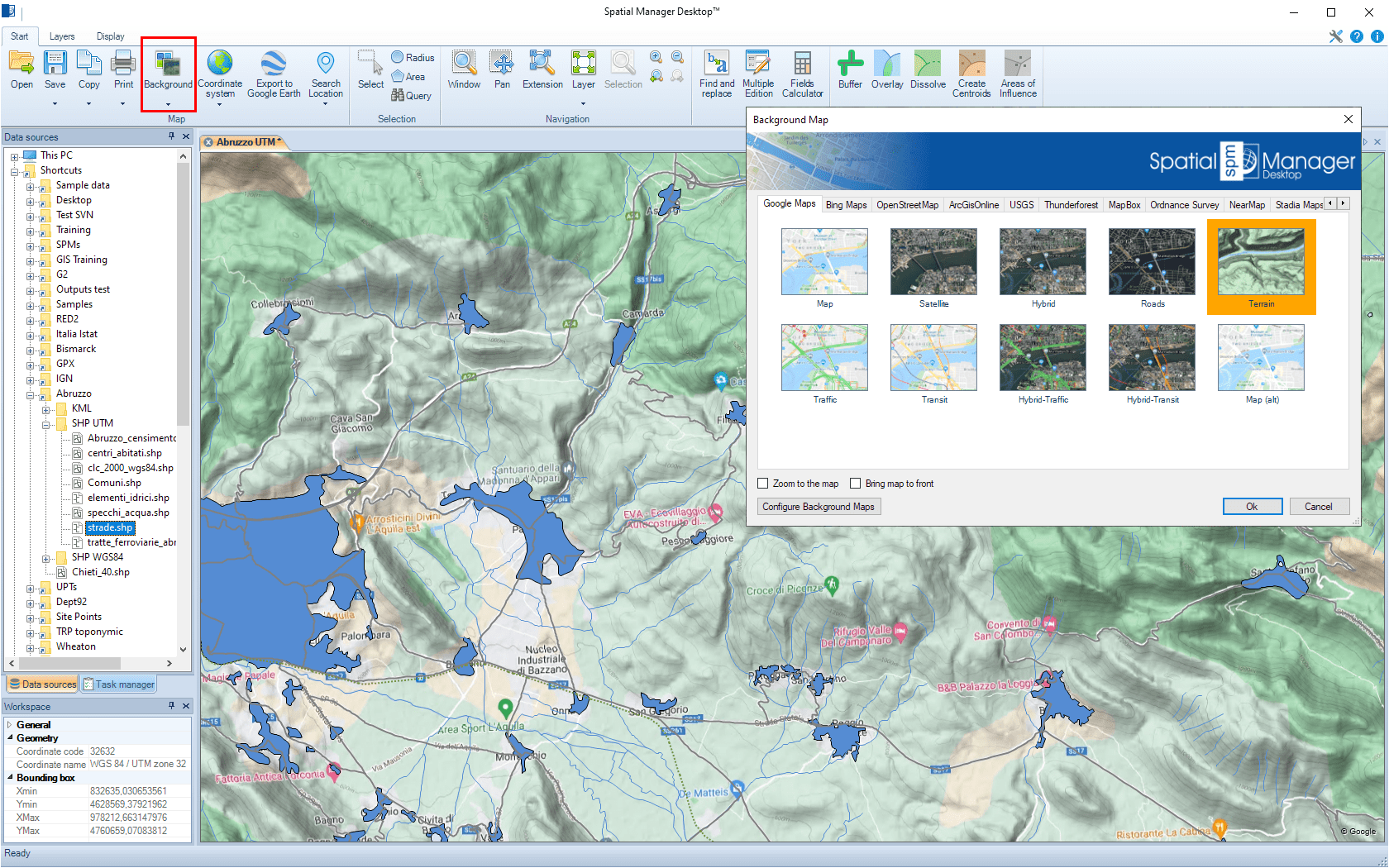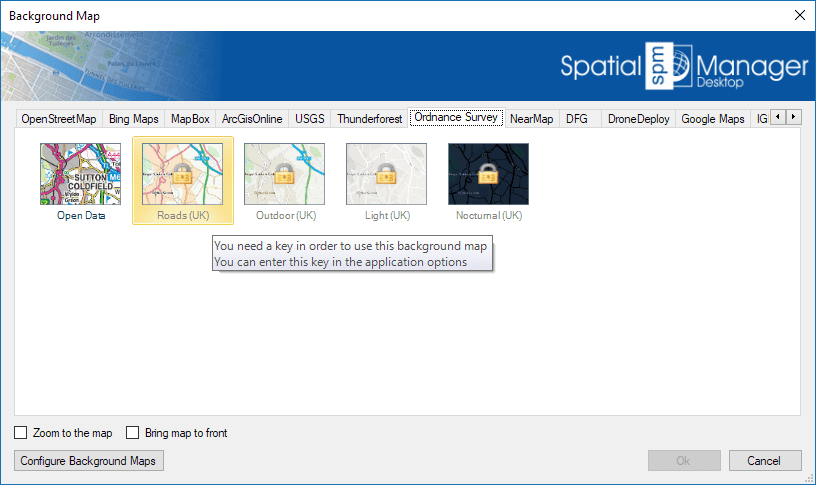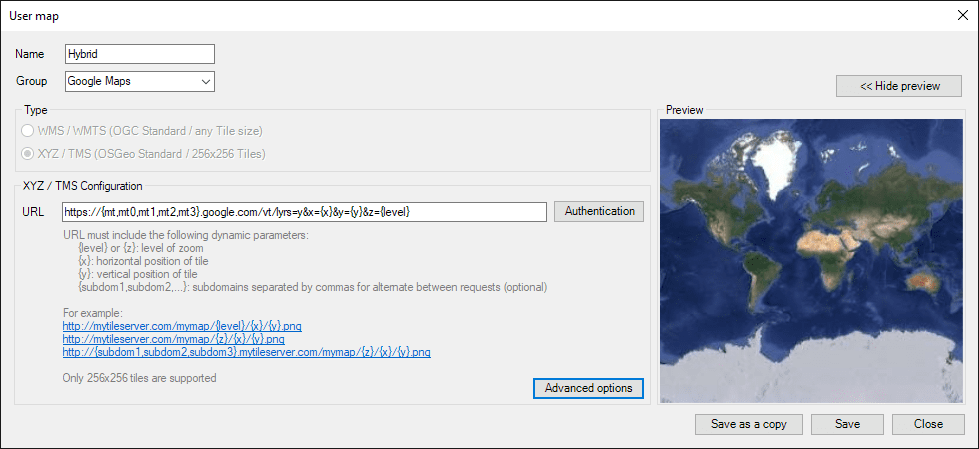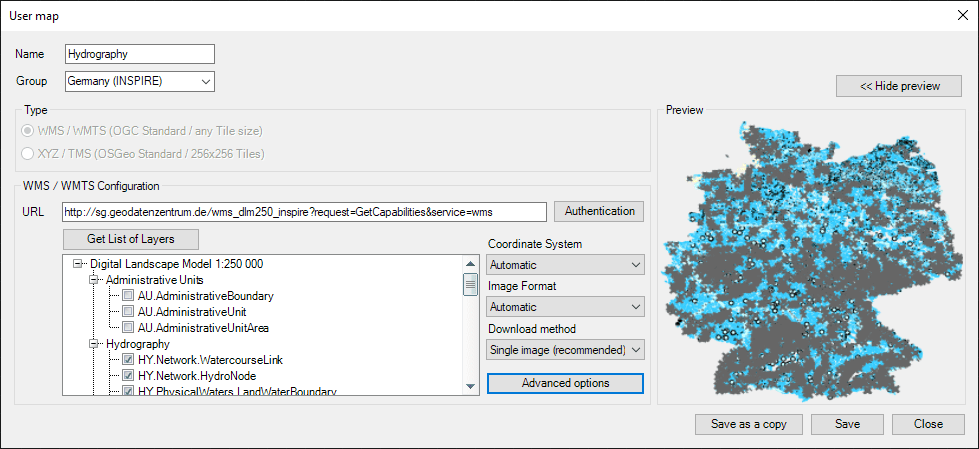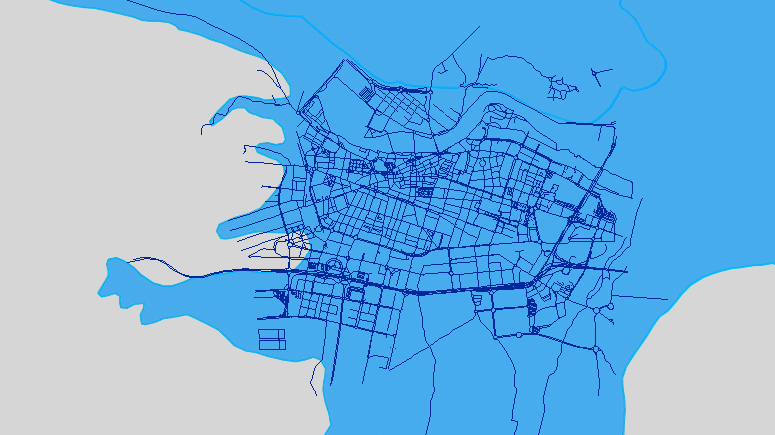Spatial Manager Desktop™ - FAQs: Background Maps
Introduction
- Objective of this section
- To learn how to show image Maps in the Background of the Maps, which can enhance their quality as well as make them more understandable
- Topics in this section
- Select 'Background Maps' models
- Configure User 'Background Maps'
Note: some components in the below windows pictures (providers, names, windows look, etc.) may be slightly different to those that will appear on your computer
How can I display a 'Background Map' in the Map?
You can select an image map model to show as 'Background Map' in the Map through the "Start" ribbon of Spatial Manager Desktop. This will open the "Background Map" window allowing you to select a model from the Maps list. You can find the list arranged using different Groups (Tabs) for the different preset Providers (OpenStreetMap, Mapbox, etc.) and the User groups (see how to Configure User 'Background Maps'). The image of the dynamic 'Background Map' is automatically adapted to the current Map view and it will be automatically fitted when the Map view changes (zoom, pan, etc.)
To change the image model map for the 'Background Map', you can run again this function. The "Background Map" window will display emphasized the current image map model, which you can keep by clicking in the "OK" button. Click in another model if you want to change to this model
Workspace view behavior when selecting a 'Background Map' and the "Zoom to the map" option:
- "Zoom to the map" selected
- If the map extension intersects the 'Background Map' extent, then the view fits to the map extension
- Otherwise the view fits to the 'Background Map' extent
- "Zoom to the map" not selected
- The view does not change. If the current view does not intersect the 'Background Map' extent, a warning alerts you about that the selected 'Background Map' is located outside the current view and that you will not see it in the view
- In any other case not covered above
- The view does not change
Note: The 'Background Map' extent is the bounding box defined in the corresponding Map Server and sometimes may be greater than the 'Background Map' geographic extent
"Bring map to front" option: When checked the map will be overlapped to all the elements in the workspace
Map in the foreground
Notes:
- Bringing the 'Background Map' to front makes sense, and it is a very practical option, when it has Transparent areas (learn more about Transparent 'Background Maps' support)
- If you add elements to your map after bringing the 'Background Map' to front, those will overlap the 'Background Map'. If you want to put the 'Background Map' in the foreground again, simply select it again and keep checked the option "Bring map to front"
Warning: Bringing the 'Background Map' to front can cause the rest of elements to be hidden (except in Transparent areas of the 'Background Map', if any)
Is there any special condition to use the 'Background Maps'?
Certain image maps providers included in Spatial Manager Desktop™ may require special terms of use for the users of their maps. You can configure any special setting needed to load the maps of such providers through the 'Background Maps' selection window ("Configure User Maps"). You can also configure and save settings the first time you try to use a 'Background Map' that needs a special configuration
Configure 'Background Maps' through the selection window
You can change the settings as often as desired. You can even insert blank values to reset the values of these settings
Sometimes, the image maps provider lets you access to some free maps but you need to get a key or code to use the others. In this case you will see "blocked" the maps which need that you modify the configuration according to the instructions above
Important note: Please, read also the specific license conditions in the paragraph relating to the 'Background Maps' of the application End User License Agreement (EULA)
Can I configure my own Web Map Services?
Yes, you can. Spatial Manager Desktop™ includes the option to define "User Background Maps" in order to enable the access to more Mapping Services (XYZ / TMS , WMTS or WMS)
Enter the parameters needed to define a new "User Background Map" through the "Configure User Maps" button in the 'Background Maps' selection window. As you will see, you can also Edit or Delete any existing "User Background Map" through the same option
"Configure User Maps" button in the 'Background Maps' selection window
- XYZ / TMS Type Maps (OSGeo Standard, only Pseudo-Mercator WGS84 and 256x256 tiles)
- The Name of the Map
- Each Map will have its own unique Identifier, so you can apply the same Name to different Maps in different Groups
- The Group (Tab) where you want to place the Map. If it comes to a new Group, it will be automatically created. You can dropdown the list of the Groups to place the Map into an existing Group
- The Type of the Map (XYZ / TMS in this case)
- The URL to access a specific valid Map in a valid Map Server. The URL must include the dynamic parameters specified in the application window
- Authentication: To enter the login data to access the service, if needed
- The Name of the Map
- WMS or WMTS Type Maps (OGC Standard, any Coordinate System and tile size)
- The Name of the Map
- The application will you propose a name for the Map based on the selected Layer(s) in the server (see below), but you can modify it if you want to
- Each Map will have its own unique Identifier, so you can apply the same Name to different Maps in different Groups
- The Group (Tab) where you want to place the Map. If it comes to a new Group, it will be automatically created. You can dropdown the list of the Groups to place the Map into an existing Group
- The Type of the Map (WMS/WMTS in this case)
- The URL to access a valid Map Server
- Authentication: To enter the login data to access the service, if needed
- The Layer(s) that you want to include in the 'Background Map'. Click in the "Get List of Layers" button and select the Layer(s) from the tree showing the complete Layers structure available in the Map Server
- The Coordinate System (CRS) for the selected Layer(s). Choose an available CRS or "Automatic" from the "Coordinate System" dropdown
- The "Automatic" option automatically configures the most suitable 'Background Map' CRS
- The Image Format for the selected Layer(s). Choose an available Format or "Automatic" from the "Image Format" dropdown
- The default "Automatic" option automatically sets the most suitable Image format, by following the next process:
- PNG
- If PNG is not available, then any PNG variant (PNG8, etc.)
- If the previous option is not available either, then JPG
- If JPG is not available, then the first format available in the server list
- The default "Automatic" option automatically sets the most suitable Image format, by following the next process:
- The Download method from the server: "Single image (recommended)" or "Image tiles grid" (WMS only)
- The Coordinate System (CRS) for the selected Layer(s). Choose an available CRS or "Automatic" from the "Coordinate System" dropdown
- The Name of the Map
Notes about the WMS/WMTS 'Background Maps' performance:
- When configuring the "Download method" for a WMS 'Background Map', choose the default option "Single image (recommended)" whenever possible
- The image quality is optimum
- This choice will assure that not be shown texts or other elements repeated multiple times when they appear in more than one image tile
- The alternative "Image tiles grid" should be used only when the "Single image" option becomes too slow
- Select any compressed image format (PNG, JPG, etc.) if available
- The images will be smaller resulting in shorter download times
- In most cases, the default "Automatic" option (see above) is the best one
When configuring a User Map, clicking in the "Show Preview" button will display an image of the Map extension in order to help you verifying if all settings are correct. The "Preview" image will be automatically updated when you modify any configuration parameter
Click in the "Save" button to save the Map and exit, or click in the button "Save as a copy" to save the Map and stay on this window. This option allows you to quickly create various Maps using similar configurations without having to go out and come back again and again. For example, in the case of WMS/WMTS Maps it is very useful for easily creating different Maps that include different Layer(s) of the same source
Does the 'Background Map' technology support Transparent maps?
Yes, Spatial Manager Desktop™ supports 'Background Maps' that include Transparency information. When you select any Transparent 'Background Map' to show it, the Transparent areas of the map will show the last Background solid color used. In addition, if the option "Bring map to front" is checked when selecting the 'Background Map', you will see the opaque areas of the 'Background Map' over the rest of the elements in your map (see the option "Bring map to front" in How can I display a 'Background Map' in the Map?)
Note: Transforming coordinates of the resulting images of a map (if needed), it is a little slower when a Transparent 'Background Map' is shown in the workspace
Related links
- Base maps as Map backgrounds
- Enhanced Background Maps. WMS & WMTS services
- Google Maps in your own Maps? Of course
- More about dynamic Google Maps in your Maps
